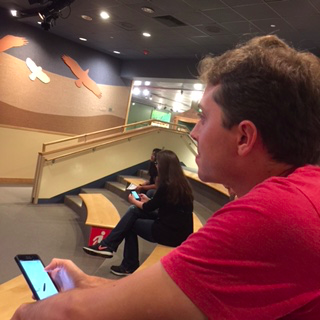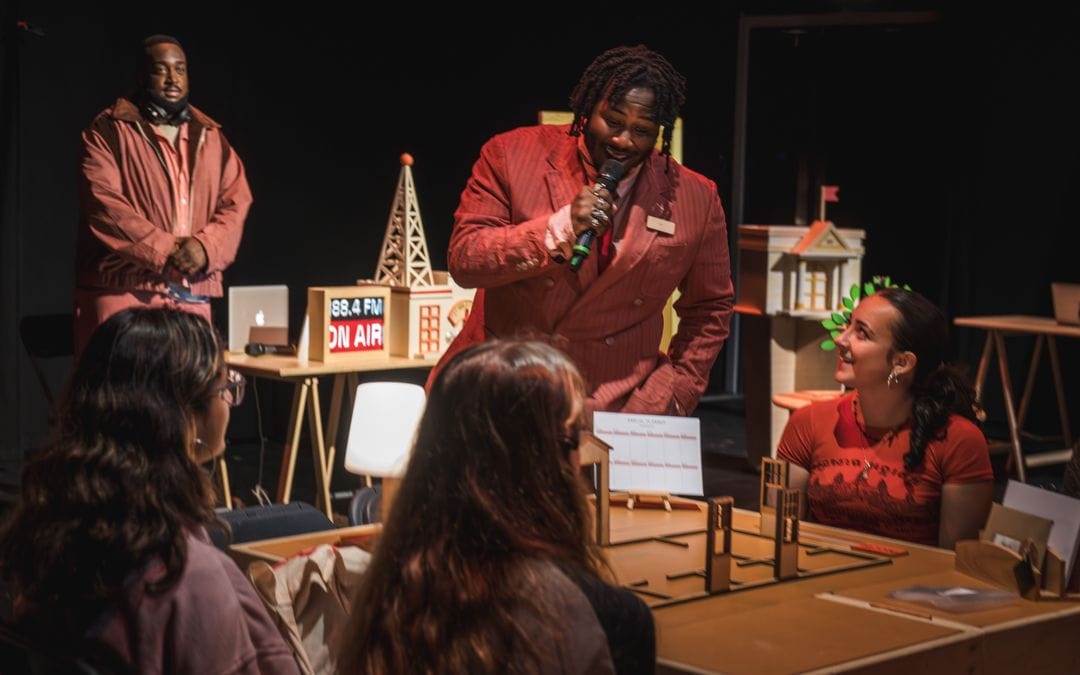
Waiting Rooms at the Boston Museum of Science advertised itself as something that would:
…transform the building into an absurdist social bureaucracy, taking you into spaces where visitors are not allowed to go. The rules will steer you as you wander from room to room, leading to situations that are sometimes collaborative and sometimes competitive. The only story that happens are the choices that you make.
Who could resist that?
We bought tickets and were excited that our friend, Brett Kuehner, would come up from New York to join us. Brett is a friend from the International Puzzle Party (IPP), a collection of the delightfully nerdy puzzle-solvers, collectors, and brainteaser enthusiasts from around the world. (Brett is a genuine puzzler, whereas I’m the +1 of my puzzler husband, but I got hooked on IPP pretty quickly.) I give you this background because as two people who know each other from the gaming world, we were both surprised when we left Waiting Rooms saying, rather disappointedly, “This is a game — but it’s not entirely immersive theatre.”

Waiting Rooms had an extremely promising beginning: being called out of the entry line by some kind of obscure algorithm, then sent to a nearby area managed by a fantastically impersonal host, who repeated instructions in a soothing voice until our number was called to begin the game. Each of the “guides” wore a matching plain gray lab coat. I waited, then I took my ticket and selected one of the several blue taped lines on the floor, heading by myself down the circular staircase. I absolutely skipped down that staircase. I followed the line assiduously (as did Brett, it turns out). Turn right here, left there, I was being a good rule follower and not even taking the obvious shortcuts. It was so mysterious to be in the museum’s exhibit hall by myself without the usual crowds. I could only imagine what adventures were at the end of this line. What was actually at the end of the line was… another waiting room.
So there I sat. And waited. This shouldn’t be a surprise, after all, it’s called Waiting Rooms. But this meant there was lots of engineered frustration. True randomness meant frustration could be high, sometimes waiting 15 to 30 minutes in one location. Just… waiting.

The intent seems to have been to talk about bureaucracy and systems, immigration, and impersonalization. And that they definitely did. There was no real goal other than to see what else could be seen. No ‘win’ condition, except for any you could define yourself. All accomplishments in Waiting Rooms are constructions coming from the players. You could define ‘wins’ how you wanted, and feel satisfied or not.
Many people made alliances and found ways around the initial game structure: trading tickets, bribing ticket takers, and, as we found at the debrief of the game, a few even stole rolls of tickets. Some people brushed past the lines while others were faithful to the rules, but it seemed like collaboration was required to get very far. People who cooperated with groups of friends were able to see more than those who played alone. People often were good at sharing and we wondered if these conditions would be the same in different cities or with different groups of people.

At the post-game debrief, game designer Eric Zimmerman said, “It’s a human system, so….” It’s true, whenever humans are involved, some will find workarounds to the system. Maybe that’s an important lesson of bureaucracy as well, but the rules were unclear to us, perhaps intentionally, and certainly to some extent frustratingly.
Personally, Waiting Rooms felt pretty isolating. I walked around by myself waiting for something magical to happen — spending tickets, collecting tickets, waiting for a story — but not really interacting with anyone other than the guides who took tickets from me. The game mechanics seemed to intentionally highlight how randomness and luck can drastically affect one’s experiences in the world. For me, the best part was when a guide who I knew from my own museum design projects came by to move me from one location to another. I was overjoyed to see a face that I knew! Someone with a smile and a hug, who wasn’t merely trying to jockey, trade, or take tickets from me. (Though my friend is a lovely person, I was especially happy to see her in this context.)

The experience of extreme bureaucracy also seemed to make others notice and appreciate what little human interaction there was. Multiple people mentioned how much they loved hanging out with ‘Michelle in the storeroom,’ a Waiting Rooms employee who played hangman and asked silly questions of us. It was odd how much that location stood out in the debrief, especially considering that it wasn’t key to the game. When ‘the storeroom’ was brought up later, there was actual cheering in the crowd and Michelle’s name was easily remembered. A woman said that a fun moment for her was when she approached me, sitting in a taped box on the cafeteria floor where I’d been waiting for about 15 minutes. I said to her, “Welcome to the cone of shame.” She thought this was a cheerful human moment after being processed impersonally for most of the game. At the time, I felt like I was being pithy and was somewhat annoyed that I was sitting on the cafeteria floor. It seemed like she was just happy to have a friendly face say hello. She said she felt like she got a look “behind the scenes.” Maybe another lesson on navigating bureaucracy?

On the flip side, my husband loved this game. I had to pull him away from Waiting Rooms. From the beginning, he recognized it as an exploitable system that required collaboration to succeed. Navigate an efficient pathway! Share information! Optimize resources! Try something and ask forgiveness later!
In fact, as he shared his experience with the other players, Brett and I blocked our ears. This was the one case where greater experience with immersive work was a drawback; spoilers actually helped here! You did not get as much out of the piece if you followed the common immersive theatre rules: keep your mask on, don’t speak unless spoken to, and avoid spoilers from others. We did not find the same unspoken rules in Waiting Rooms.
Some players collaborated to draw a map on a whiteboard during the game. In some ways, that was the most satisfying thing you could do during Waiting Room. But it would be antithetical create a map during an immersive theatrical experience. Such an act feels wrong if your expectations were different. If you drink a glass of orange juice while expecting milk, you are not going to have a good “orange juice experience.”

The audience was largely white and on the younger side, though not exclusively. I felt that Waiting Rooms really played into the MIT/board gamer culture of our fair city of Boston. In a similar academic, systems simulation sort of way, it seemed like the best experience was actually from the creator’s or observer’s perspective. From ‘god view,’ you could watch the player interactions and examine how the gameplay evolved and the micro-societal rules were formed, were observed, and were then broken. As players, we missed most of that perspective, except during the discussion afterward. It would have been more interesting if these emergent societal norms were presented during the finale.
As a game designer, I can appreciate that the game was tight and well-constructed. Pathways were fun and used the space well. There were great dynamics in elevators and in the lines that took you outside the museum, into offices, and into unexpected corners. This experience was originally run at the Rubin Museum of Art in New York City. The transition to the Boston Museum of Science took about a year, meaning the kinks had been worked out and the mechanics of the game ran like clockwork. The non-player characters performed their assigned roles very well, as gray-clad cogs in the larger machine, who impersonally enforced the rules.

If only… (and I know it’s a big if only), there were more of a theatrical feel. I wanted the guides to be characters. I wanted them to be toeing some sort of imaginary dystopian party line. A few did and it made a big difference. The line between ‘game’ and ‘immersive experience’ came down to actors not expressing any kind of story. It’s not that they did it wrong. They weren’t asked to tell a story. Just a little bit of ‘story’ and ‘improv’ could have taken Waiting Rooms to the next level. All in all, this was a solid, unique game that went off without a hitch in a great location. Brett thought it was a bit, well, ‘unfun.’
“I’m not going to classify my experience as ‘fun,’” he wrote. “Waiting Rooms contained too much (largely intentional) frustration to qualify as ‘fun.’ It was interesting, and as a person who thinks about game design, I also extracted value that way. But ‘fun’ is not the word I’d use.”
I can’t say I disagree.
No Proscenium is a labor of love made possible by our generous Patreon backers: join them today!
In addition to the No Proscenium web site, our podcast, and our newsletters, you can find NoPro on Twitter, Facebook, YouTube, Instagram, and in our online community EverythingImmersive.com.




















Discussion